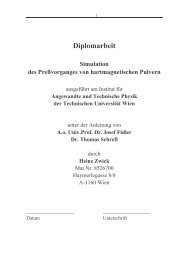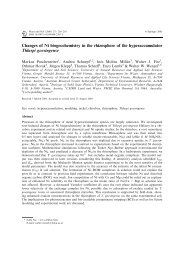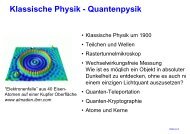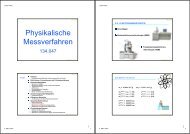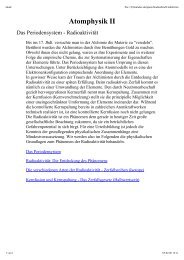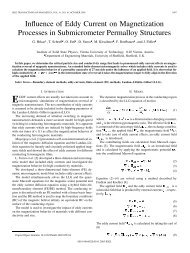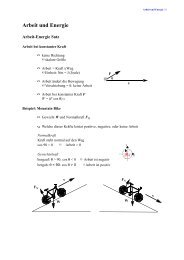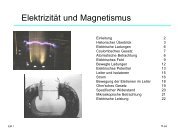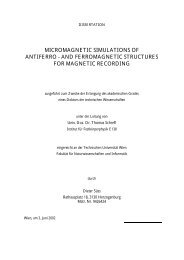Read Back Signals in Magnetic Recording - Research Group Fidler
Read Back Signals in Magnetic Recording - Research Group Fidler
Read Back Signals in Magnetic Recording - Research Group Fidler
You also want an ePaper? Increase the reach of your titles
YUMPU automatically turns print PDFs into web optimized ePapers that Google loves.
s<br />
Basics<br />
∂J α ∂J<br />
=−γ J× Heff + J × . (2.47)<br />
∂t J ∂t<br />
This equation is mathematically equivalent to the Landau-Lifshitz-Gilbert equation (LLG)<br />
∂Jγ γ α<br />
=− J× Heff − J× ( J× H eff ) . (2.48)<br />
∂ t +α J +α<br />
2 2<br />
( 1 ) s ( 1 )<br />
Here J s is the spontaneous polarization and γ is the gyromagnetic ratio<br />
5<br />
γ= 2.210175× 10 m/As . The first term <strong>in</strong> this equation describes the precessional movement<br />
of the magnetic polarization vector J around the effective field H eff . The second<br />
phenomenological term stands for the energy dissipation dur<strong>in</strong>g the movement and causes a<br />
movement towards the direction of the effective field. The motion of the magnetization is<br />
visualized <strong>in</strong> Figure 2.1a. The strength of the damp<strong>in</strong>g is characterized by the dimensionless<br />
Gilbert damp<strong>in</strong>g constant α . Large α means strong damp<strong>in</strong>g. There are many processes<br />
which contribute to the damp<strong>in</strong>g <strong>in</strong> magnetic solids, for example magnon-magnon, magnon-<br />
phonon <strong>in</strong>teractions, or eddy currents. So the damp<strong>in</strong>g constant is an <strong>in</strong>tr<strong>in</strong>sic property of<br />
matter and can also be varied <strong>in</strong> practice, for <strong>in</strong>stance by dop<strong>in</strong>g [14]. In general, except for<br />
th<strong>in</strong> layers (see Section 6.2.4), high damp<strong>in</strong>g constants lead to coherent motion of the<br />
magnetization and therefore to faster reversal processes. Figure 2.1b shows the field of a<br />
simulated write head as function of time for different Gilbert damp<strong>in</strong>g constants. It can be<br />
seen that for damp<strong>in</strong>g constants of about 0.5 the fastest switch<strong>in</strong>g time is achieved [43].<br />
∂ J<br />
In equilibrium, thus if = 0 , equation (2.47) simplifies to<br />
∂t<br />
J× H eff = 0,<br />
(2.49)<br />
which means that <strong>in</strong> equilibrium the magnetic polarization J is aligned either parallel or<br />
antiparallel to the effective field H eff . The unrealistic case of antiparallel alignment is<br />
irrelevant, because this solution is not stable, and <strong>in</strong> this case small deviations lead to a<br />
movement <strong>in</strong> direction of the effective field due to the damp<strong>in</strong>g term <strong>in</strong> (2.48) (see also Figure<br />
2.1a).<br />
19



